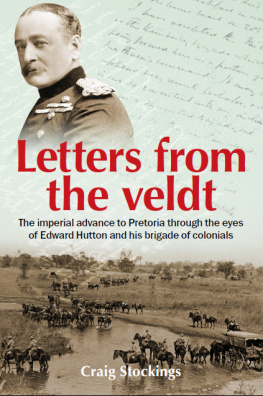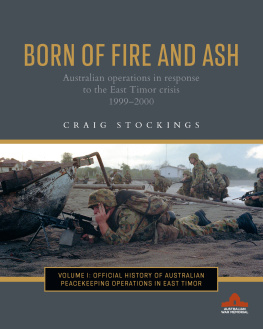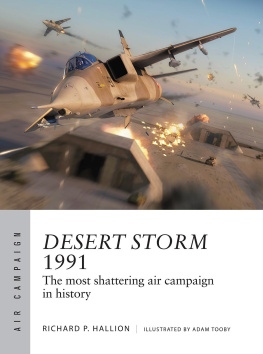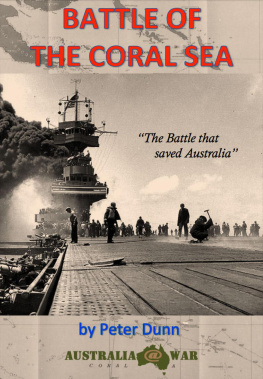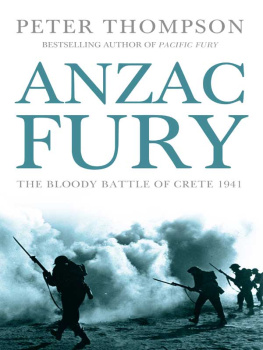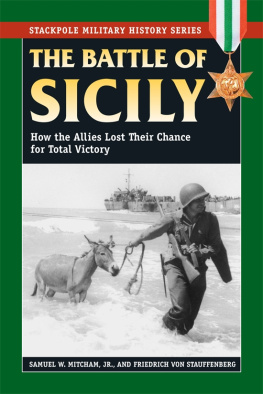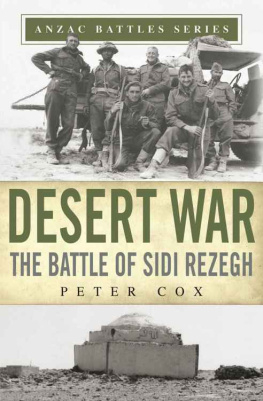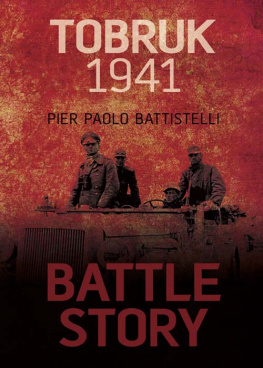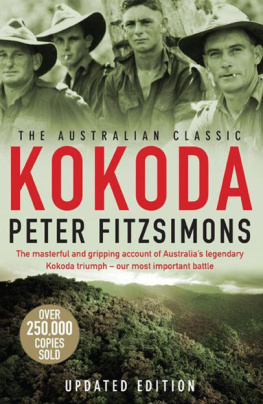 | AUSTRALIAN ARMY CAMPAIGNS SERIES - 9 |
THE BATTLE OF
BARDIA
C RAIG S TOCKINGS


Copyright Army History Unit
Campbell Park Offices (CP2-5-166)
Canberra ACT 2600
AUSTRALIA
(02) 6266 4248
(02) 6266 4044 fax
Copyright 2011 Commonwealth of Australia
First published 2011
This book is copyright. Apart from any fair dealing for the purposes of private study, research, criticism or review as permitted under the Copyright Act, no part may be reproduced, stored in a retrieval system or transmitted in any form or by any means, electronic, mechanical, photocopying, recording or otherwise, without written permission.
National Library of Australia Cataloguing-in-Publication entry
Layout & Design by Think Productions, Victoria
Printed by Big Sky Publishing, Sydney
Design and typesetting by Think Productions, Melbourne
Title page image: Post II, painting by Ivor Hele. (AWM ART27576)
Contents
Series Introduction
In 2004, the then Chief of Army Advisory Group, the Armys senior generals, established a scheme to promote the study and understanding of military history within the Army. The focus was to be on Armys future generation of leaders and from this the Campaign Series was created. The series is intended to complement Armys other history publications which produces high quality, academically rigorous and referenced major analytical works.
The Campaign Series focuses on leadership, command, strategy, tactics, lessons and personal experiences of war. Each title within the series includes extensive visual sources of information maps, including specifically prepared maps in colour and 3D, specifically commissioned artwork, photographs and computer graphics.
The Campaign Series covers campaigns and battles that comprise major conflicts as well as those battles or campaigns that are less well known. The Australian Army History Unit sees this series growing into a significant contribution to the history of the Australian Army and one that will provide an excellent introduction to the campaigns and battles it has fought.
Roger Lee, Army Historian
Acknowledgements
This book truly represents a team effort. I would first like to acknowledge the guidance and coordination provided to the project by Mr Glenn Wahlert, himself a contributor to this series. Glenn is also responsible for the layout, sidebars, many of the graphics, and the coordination of artwork within it. My sincere thanks also to Mr John Donovan, whose friendly and thorough editing turned a very rough narrative into something much more readable. I am also grateful for Mr Mark Wahlerts first-rate work on the many maps that appear in the book. Last, I must acknowledge Mr Roger Lee and the Australian Army History Unit. Roger and his organisation continue to fulfil a vital role in the promotion and support of research into the history of the Australian Army and military history in wider terms. Beyond those explicitly noted, although I cannot name all those who helped shape this book since its gestation, I sincerely offer my thanks, and hope the book proves worthy of their efforts.
Abbreviations
AIF | Australian Imperial Force |
GaF | Guardia alla Frontiera (Frontier Guards) |
L3 | Carro Veloce L3/35 (CV-35) light tank |
M13 | Fiat-Ansaldo M13/40 medium tank |
NCO | non-commissioned officer |
RB | The Rifle Brigade |
RHA | The Royal Horse Artillery |
RN | Royal Navy |
RNF | The Royal Northumberland Fusiliers |
RTR | The Royal Tank Regiment |
WDF | Western Desert Force |
Introduction
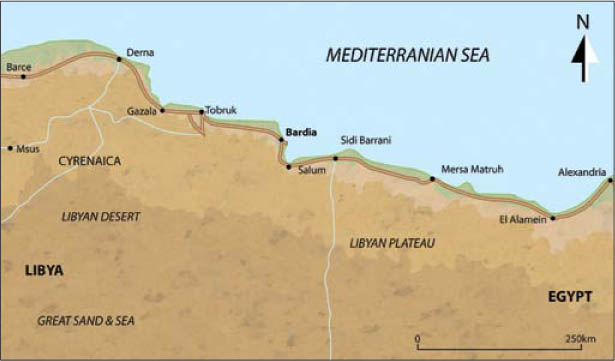
The Western Desert (Mark Wahlert)
On the morning of 3 January 1941, Australian soldiers led an assault against the Italian colonial fortress town of Bardia. The fortress fell two days later after almost 55 hours of heavy fighting. The victory cost the attackers 129 men killed and 329 wounded. Italian losses were close to 1000 dead, some 3000 wounded, and a further 36,000 taken prisoner, including the five Italian divisional commanders present.
In numerical terms alone, leaving aside the vast quantities of military stores and equipment captured, the battle was a monumental Australian success. Five days after the battle ended it was described by Chester Wilmot, famous Australian war correspondent and author, as one of the greatest feats in Australian military history, a triumph of brilliant tactics, courage, speed and coordination. This book is its story.
The village of Bardia is situated on a small harbour on the Mediterranean coast of what was, in early 1941, Italys Libyan colony. Located a short distance west of the Egyptian border in the province of Cyrenaica, it had been developed between the wars as a military outpost, and was fortified with a string of defensive posts, almost 30 kilometres long, built in a semi-circular arc around the town.
Although Bardia was a sleepy village with a sedentary garrison in the years leading up to the Second World War, Italian dictator Benito Mussolinis declaration of war on Britain and France in June 1940 dramatically increased its strategic significance, and sealed its fate. The strategic background to the battle is discussed in The Western Desert Campaign 1940-41, another volume in the Australian Army Campaign Series.
The fortress was used as a staging area for an abortive Italian invasion of Egypt in September 1940. Two months later, after a strikingly successful British counter-offensive, Bardia found itself on the front line as an obstacle to the continuing British advance into Libya. In the last weeks of 1940 it was effectively besieged. At this time the men of the 6th Australian Division, who began arriving in the Middle East in February 1940, were called to put into effect what they had been practising. It was time to test the heirs of ANZAC.
Beyond the scale of victory, Bardia was significant then, and remains important now, as the first battle of the Second World War in which an Australian formation took part. It was also the first significant action of that war commanded by an Australian general and organised by an Australian staff.
Bardia is not familiar to the wider Australian public. Very few have heard the name, except those with a specialised interest in Australian military history. It is a story, however, well worth telling, an epic, but also intensely human, tale. Any battle is the sum of individual trial and experience, and the story of Bardia overflows with heroism, cowardice, skill, incompetence, bravery and blunder, on both sides. It is well past the time to give Bardia, and those who fought there, the attention they deserve.
CHAPTER 1:
Bardia Fortress and the Plan to take it
In the 16 months from the outbreak of the Second World War to the end of 1940, events in North Africa moved at an increasing pace. On 11 June 1940, the day after Italy declared war on Britain and France, Italian forces stationed in Libya and the British and Commonwealth forces stationed in Egypt began a series of raids upon each other.
Next page

